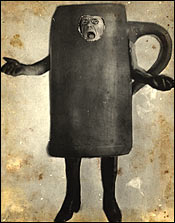
What if you took the gargoyle from the cathedral? You’d lose a keystone. Not only do the devilish imps provide a necessary counterpoint to the heavenly choir, but they represent a vital, desperate, and cathartic joy. Like the angels who move between the human and the divine, gargoyles dance along an existential edge—in their case, between the human and a fantastical darkness. Sometimes, in fact, only a grinning gargoyle can adequately convey the intractable contradictions and exfoliating idiocy of the world. During a sequence of early movies by Karl Valentin, now on view in “Comic Grotesque: Wit and Mockery in German Art, 1870–1940” at the Neue Galerie, there is a moment when Valentin no longer makes jokes or tells a slapstick story: He stops trying to explain. Instead, he simply twists his features into a grotesque face, becoming a perfect modern gargoyle.
“Comic Grotesque,” organized by the independent curator Pamela Kort, focuses on various versions of the grotesque found in Germany up until World War II. In addition to drawings, paintings and posters, it includes a few Dada works and some photographs (as well as films) of Valentin. The show should be popular not just because people are always curious about the grotesque, but because our own situation today cries out for a master of grotesquerie. The best such artists do not simply caricature this or that pooh-bah; that’s too easy. Instead, they create an image—sometimes comical, sometimes not—of the whole rotten human situation. At the recent town-hall presidential debate, if this were a more poetically just world, every member of the audience would have appeared wearing (as Valentin often did) an extended nose. And as the candidates spoke, they would have developed magnificent dueling proboscises.
Before the modern period, the art of the grotesque was often placed in a religious context. That is, it was carefully controlled. Hieronymus Bosch was not an artist with a bat cave for an imagination but a light-bearing Christian moralist. In the eighteenth and nineteenth centuries, such constraints loosened. Goya’s Black Paintings released “gargoyles” from any social or religious framework; artists regularly used the grotesque to violate boundaries. The Swiss Symbolist Arnold Böcklin (1827–1901) created comic mythological scenes to subvert the elevated tone of classical art: In one picture, two oafish Pans net a mermaid and will make a fine meal of her. In another picture, Adoration (The Potbelly), the young Alfred Kubin (1877–1959) depicted a naked supplicant kneeling before what looks like a pregnant anteater.
Not surprisingly, many artists interested in the grotesque lampooned contemporary society, especially as social and political tensions sharpened during and after World War I. The modern gargoyle-makers distorted the human figure into vile, often animal-like forms. John Heartfield (1891–1968) made bitter photomontages that excoriated the Nazis, for example, turning one into a “peaceable predatory fish.” Georg Scholz (1890–1945) painted an image called Industrial Farmers in which a farm family (a group of people usually idealized) seems to have developed into creatures that are half-machine and half-pig. When he was young, Lyonel Feininger (1871–1956) drew many caricatures for magazines, some of them very broad. But he also made a mysterious painting, The White Man, in which a ghostly, elongated figure as tall as a building strides through the night streets smoking a pipe.
Artists associated with Dada savaged the body, mocking both art and the larger “body politic.” Heartfield and Hannah Hoch (1889–1978) turned contemporary Germans into puppets. People today who remember the 1960s—when demonstrators often called policemen “pigs”—will be startled to see the reconstruction of Heartfield and Rudolf Schlichter’s Prussian Archangel, a flying pig–military man who soared over a Dada exhibition in 1920. Works that do not make such obvious political points, however, have the stronger impact: They don’t allow the viewer to escape easily from any existential problem by pointing a finger at a stupid “other.” Valentin could sometimes achieve this disturbing effect with slapstick. He was a kind of performance artist who created a body that seemed inherently unstable, one that could never finally adapt to any settled context. In one slapstick film called The New Desk, he tried unsuccessfully to fit himself to a task by repeatedly shortening the legs of desk and chair.
“Comic Grotesque” is not a precisely focused show, partly because the grotesque is not itself a style. Many of its devotees during this period worked within various well-known isms, such as Dada, Surrealism, and the different forms of German Expressionism. What is and isn’t grotesque is not always clearly defined. Some of the art on view is not particularly comic, and in any case it’s odd to treat only comic expressions of the grotesque. Perhaps jaded contemporary viewers, accustomed to the conventions of art-shock, will even find such work rather tame. (For one thing, there’s not much nasty sex.) But the overall mood of the exhibit—enhanced by the unusual pastel-hued walls—has the disturbing, tug-at-your-sleeve intimacy of gargoyles. And the slightly musty, gothic air creates a provocative contrast with our own culture. Today, the grotesque is more likely to be shiny-faced, like the celebrity-gargoyles in the movie Team America.

The Charlie Chaplin of the Munich Dadaists, Karl Valentin (1882–1942) embodied the grotesque in his cabaret performances and silent films: first as a nonspeaking musical clown, and later as a verbal comedian constantly stumbling over literal interpretations of popular idioms. He also kept a remarkable photo archive of his onstage personae, from a mad scientist to a talking beer mug. Brecht was an early fan of Valentin’s anti-authoritarian antics, but the Nazis, who banned his 1936 film about poverty, Die Erbschaft (“The Inheritance”), were less amused.
Comic Grotesque
At the Neue Galerie. Through February 14.